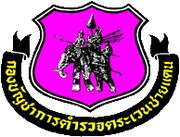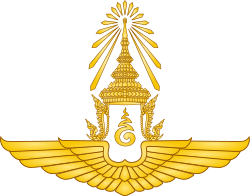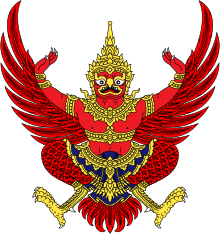Border Patrol Police
The Border Patrol Police (Thai: ตำรวจตระเวนชายแดน); (BPP) is a Thai paramilitary under the jurisdiction of the Royal Thai Police, responsible for border security and counter-insurgency.
| Border Patrol Police Royal Thai Police | |
|---|---|
| ตำรวจตระเวนชายแดน สำนักงานตำรวจแห่งชาติ | |
 Border Patrol Police | |
| Active | 1951–present |
| Country | Thailand |
| Branch | |
| Type | Paramilitary force |
| Role | Border guard Counter-insurgency |
| Nickname(s) | Tor. Chor. Dor. (ต.ช.ด.) |
| Engagements | |
History
The Thai Border Patrol Police was organized in the 1951 with assistance from the United States Central Intelligence Agency. Although technically part of the Royal Thai Police (RTP), the BPP has always enjoyed a great deal of autonomy within the national headquarters as well as in its field operations. The royal family was a principal patron of the organization. This traditional relationship benefited both the palace and its paramilitary protectors. Many BPP commanders were former army officers.[1]
Organization
.jpg)
National Organization
- Headquarters Border Patrol Police Bureau
- General Staff Division
- Special Training Division
- Support Division
- Police Aerial Reinforcement Unit (PARU)
- Village Scout Center
- 1st Border Patrol Police Regional Divisions.
- 11th Border Patrol Police Regional
- 12th Border Patrol Police Regional
- 13th Border Patrol Police Regional
- 14th Border Patrol Police Regional
- 2nd Border Patrol Police Regional Divisions
- 21st Border Patrol Police Regional
- 22nd Border Patrol Police Regional
- 23rd Border Patrol Police Regional
- 24th Border Patrol Police Regional
- 3rd Border Patrol Police Regional Divisions
- 31st Border Patrol Police Regional
- 32nd Border Patrol Police Regional
- 33rd Border Patrol Police Regional
- 34th Border Patrol Police Regional
- 4th Border Patrol Police Regional Divisions
- 41st Border Patrol Police Regional
- 42nd Border Patrol Police Regional
- 43rd Border Patrol Police Regional
- 44th Border Patrol Police Regional
Field organization
Platoons of 32-men form the basic operating units of the BPP. Each platoon is supported by one or more heavy weapons platoons stationed at the regional and area RTP headquarters. PARU can airlift BPP platoons to troubled areas when an emergency arises. Armed with modern light infantry equipment, the BPP also benefited from training by United States Army Special Forces advisers who helped establish an instruction program during the 1960s.
The BPP served as an important adjunct to the Thai military and often operated under army (and sometimes the Royal Thai Marine Corps) control during counterinsurgency operations.
BPP units stationed along the Cambodian and Laotian borders following the Vietnamese invasion of Cambodia in 1979 often served as a first line of defense and bore the brunt of Vietnamese attacks.
In order to carry out its intelligence mission, the BPP operates numerous civic action programs to cultivate and maintain rapport with remote area villagers and hill tribes. They have built and operate schools in remote areas and help the army construct offices for civilian administration. They operate rural medical aid stations, give farmers agricultural assistance, and have built small airstrips.
Border Patrol Police Aerial Reinforcement Unit
The Border Patrol Police Parachute Aerial Resupply Unit (BPP PARU or PARU) is the BPP's special forces unit responsible for training and supporting airborne operations, airborne reinforcement, disaster and accident rescue, and supporting special missions under the command of the BPP. All members of PARU are trained for airborne operations, including free-fall jumps. PARU can provide support to BPP headquarters within two hours. The PARU in the 1950s and 1960s was a small unit used for clandestine missions outside Thailand. It was largely CIA-funded at that time.[2]:51 PARU's counts its founding from 27 April 1954, when King Bhumibol visited the opening ceremony of the PARU Company's Naresuan Camp in Hua Hin.[3]:92
PARU also conducts training for the following:
- unconventional warfare, counter-terrorism, and parachute training of the Royal Thai Police.
- disaster and accident rescue on land and water including air-sea rescue.
Subordinate paramilitary forces
Volunteer Defense Corps
The BPP organized the paramilitary Volunteer Defense Corps or VDC (the Or Sor) in 1954 to provide law and order and emergency response. This was done in response to complaints of banditry and harassment by subversive organizations. The VDC had the responsibility of protecting inhabitants from threats and intimidation by guerrillas who had infiltrated the border provinces from neighboring Laos, Cambodia, and Malaysia. Its mission is to deny insurgents access to food and other supplies that made villages and farms their targets. VDC members were trained by the BPP. In 1974 it was expanded by the Internal Security Operations Command (ISOC) to urban areas to fight left-wing political activism. In the late 1980s, VDC strength was estimated at roughly 33,000, down from a peak of about 52,000 in 1980. Part of the reduction was absorbed by the formation of the Thahan Phran, a paramilitary unit formed to counter communist insurgents. They were reinvigorated and have played a role in the fighting the South Thailand insurgency since 2004.[4]
Village Scouts
The BPP, together with the Ministry of Interior, backed and sponsored the 1971 establishment of the "Village Scouts", a right-wing rural vigilante group and paramilitary militia.[5] The village scouts were to counter the communist insurgency and the pro-democracy movement of the 1970s. Soon after its creation, five million Thais (10 percent of the population) went through the organisation's initiation rite and took its five-day training course. The Village Scouts conducted the anti-leftist rally that led to the Thammasat University massacre and bloody coup d'état on 6 October 1976.[6] The Village Scouts disappeared around 1981, but were revived around 2004 against the backdrop of the Muslim separatist conflict in south Thailand.[7] The village scout concept was extended to ลูกเสือบนเครือข่ายอินเทอร์เน็ต ('Village Scouts on the Internet') internet activities with the creation of the "cyber scouts".[8]
Thahan Phran
The 10,600 member Thahan Phran ("Rangers") was formed as a volunteer militia force deployed to active trouble spots along the Cambodian and Burmese borders. The paramilitary organization had 32 regiments and 196 companies. The Thahan Phran gained considerable publicity and incurred significant casualties during Vietnamese bombardments and local assaults along the Cambodian border.[9] Since 2004, they have deployed to counter the South Thailand insurgency.[10]
See also
References
- http://www.country-data.com/cgi-bin/query/r-13813.html
- Rattanasengchanh, Phimmasone Michael (2012). Thailand's Second Triumvirate: Sarit Thanarat and the military, King Bhumibol Adulyadej and the monarchy and the United States. 1957-1963 (MA Thesis). Seattle: University of Washington. Retrieved 26 April 2017.
- Hyun, Sinae (2014). Indigenizing the Cold War: Nation - Building by the Border Patrol Police of Thailand, 1945 - 1980 (Dissertation). Madison: University of Wisconsin. Retrieved 15 August 2018.
- "Southern Thailand: The Problem with Paramilitaries", Asia Report, International Crisis Group (140): 14–15, 23 October 2007, archived from the original on 8 February 2011
- Anderson, Benedict (1998), The Spectre of Comparisons: Nationalism, Southeast Asia, and the World, Verso, p. 159
- Suksamran, Somboon (1982), Buddhism and politics in Thailand, Institute of Southeast Asian Studies, pp. 79–80
- Horstmann, Alexander (2007), "Violence, Subversion and Creativity in the Thai-Malaysian Borderland", Borderscapes: Hidden Geographies and Politics at Territory's Edge, University of Minnesota Press, p. 149
- Nicholas Farrelly (2 July 2010). "From Village Scouts to Cyber Scouts". New Mandala. Retrieved 10 February 2011.
- Ball D. The Boys in Black: The Thahan Phran (Rangers), Thailand's Para-Military Border Guards. Bangkok, Thailand: White Lotus Press, 2004.
- "Southern Thailand: The Problem with Paramilitaries", Asia Report, International Crisis Group (140): 4–13, 23 October 2007, archived from the original on 8 February 2011
![]()
External links
| Wikimedia Commons has media related to Border Patrol Police (Thailand). |


